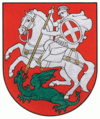Varniai
From Wikipedia, the free encyclopedia
| Varniai | ||
|---|---|---|
| City | ||
 | ||
| ||
 Varniai | ||
| Coordinates: 55°44′0″N 22°22′0″E / 55.73333°N 22.36667°ECoordinates: 55°44′0″N 22°22′0″E / 55.73333°N 22.36667°E | ||
| Country |
| |
| Ethnographic region | Samogitia | |
| County | Telšiai County | |
| Municipality | Telšiai district municipality | |
| Eldership | Varniai eldership | |
| Capital of | Varniai eldership | |
| First mentioned | 1314 | |
| Granted city rights | 1950 | |
| Population (2005) | ||
| • Total | 1,310 | |
| Time zone | EET (UTC+2) | |
| • Summer (DST) | EEST (UTC+3) | |

Samogitian Diocese seat in Varniai
It was established in the 14th century, on the bank of the Varnelė River, near an important Samogitian castle. It was the center of Samogitian Catholic church: after the baptism of Samogitia, the Samogitian Bishop resided in the town. Around 1414–1416 the first church was built, and circa 1464 the first cathedral.
Varniai was the center of Samogitian episcopate until the middle of the 19th century, when authorities of the Russian Empire moved to it Kaunas.
With support of Merkelis Giedraitis, Mikalojus Daukša translated and made ready for publication Katechizmas, the first Lithuanian language book printed in the Grand Duchy of Lithuania.
It was also residence of Motiejus Valančius.
Notable residents
External links
| Wikimedia Commons has media related to Varniai. |
- (Lithuanian) Varniai – A Resourceful Renaissance Center of 16th Century Cultural and National Ideology
- (Lithuanian) Park of Varniai and history of Varniai
- (Lithuanian) Museum of Samogitian episcopate
- (Lithuanian) Website of Varniai
| ||||||||||||||||
This article is issued from Wikipedia. The text is available under the Creative Commons Attribution/Share Alike; additional terms may apply for the media files.

